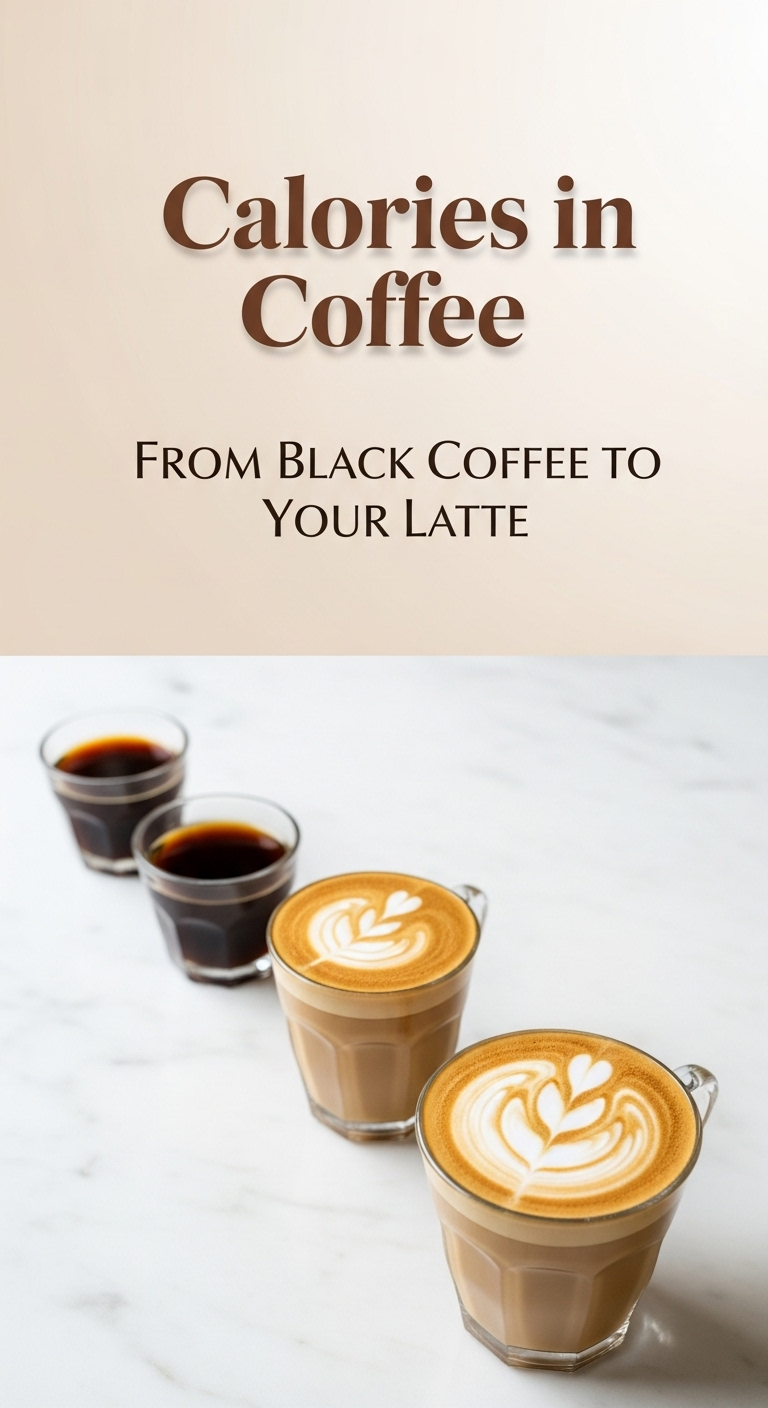As an Amazon Associate CoffeeXplore.com earns from qualifying purchases.
Calories in Coffee: From Black Coffee to Your Latte
So, you’re wondering if there are calories in coffee? It’s one of the most common questions for coffee lovers and health-conscious individuals alike, and the answer can be surprisingly complex. You might have heard that coffee is a zero-calorie wonder, but then see coffee shop menus listing drinks with hundreds of calories. This guide will clear up the confusion for good.
A plain 8-ounce cup of brewed black coffee has fewer than 5 calories and contains no fat. The calorie count rises dramatically only when you add extras like milk, sugar, cream, or flavored syrups, which can turn a simple beverage into a high-calorie dessert.
Leveraging an extensive analysis of nutritional data, this guide unpacks the exact calorie counts in every type of coffee, from a straight shot of espresso to your favorite sweetened latte. We will break down precisely how each addition impacts the total, giving you the power to make informed choices that fit your lifestyle.
Key Facts
- Black Coffee is Nearly Calorie-Free: An 8-ounce cup of plain, brewed black coffee contains only 1 to 5 calories, making it an excellent choice for calorie-conscious diets.
- Additives Are the Main Culprit: The vast majority of calories in coffee drinks come from additions. Data shows that a single coffee beverage can exceed 500 calories with enough milk, sugar, and whipped cream.
- Sugar Adds Up Quickly: Just one teaspoon of white sugar introduces about 16 calories to your drink, a number that can quickly multiply with each spoonful.
- Milk Choices Matter Significantly: The type of milk you choose has a major impact. For instance, an ounce of whole milk adds around 19 calories, whereas an ounce of unsweetened almond milk adds as few as 4 calories.
- Popular Drinks Can Be Deceptive: A typical coffee shop mocha can contain between 200 and 400 calories, often rivaling a candy bar due to the combination of chocolate, milk, and other additions.
Are There Calories in Coffee? The Definitive Answer
A plain 8-ounce cup of brewed black coffee contains very few calories, typically between 1 and 5, and has no fat. The calorie count only increases significantly with additions like milk, sugar, or cream.

That’s the simple answer. A standard cup of straight coffee is one of the lowest-calorie beverages you can drink, with most sources confirming it has less than 5 calories and virtually no fat. The minimal calories that do exist come from trace amounts of proteins and oils extracted from the coffee beans during the brewing process. Since coffee is overwhelmingly composed of water, the calorie contribution is negligible.
Plain, unadulterated black coffee is an exceptionally low-calorie drink. It’s the additions that transform its nutritional profile.
But if black coffee is nearly calorie-free, why are some coffee drinks so high in calories? The answer lies in what you add.
A Closer Look: Calorie Count in Plain Black Coffee
Plain black coffee, regardless of brew method, is exceptionally low in calories. An 8-ounce cup of brewed or cold brew coffee has 2-5 calories, while a single espresso shot has only 1-3 calories.
Before we dive into the additives that pack on the calories, it’s essential to establish a baseline. No matter how you prepare it, black coffee is not a significant source of calories.
Here’s a breakdown of the most common types of plain black coffee:
| Coffee Type | Serving Size | Approximate Calories |
|---|---|---|
| Brewed Coffee | 8 oz (240 mL) | 2-5 calories |
| Espresso | 1 shot (1 oz / 30 mL) | 1-3 calories |
| Cold Brew | 8 oz (240 mL) | 2-5 calories |
Why so few? It’s because you’re not consuming the bean itself, but rather water that has been infused with its flavors and a tiny fraction of its oils and soluble proteins. The bean’s core components stay behind in the filter or puck.
Quick Fact: Did you know a single shot of espresso has only about 1 to 3 calories? It’s concentration of flavor, not calories!
How Additives Transform Your Coffee: A Calorie Breakdown
Additions are the primary source of calories in coffee. Ingredients like milk, sugar, syrups, and cream can dramatically increase a drink’s calorie count from under 5 to over 500, turning a simple beverage into a high-calorie dessert.
Think of black coffee as a blank canvas. Every splash of milk and spoonful of sugar is a new brushstroke of calories. This is the most significant factor when asking “are there calories in coffee?”. While the coffee itself is innocent, its companions are not.
The main culprits that transform your low-calorie coffee into a dessert in a cup include:
* Milks and Dairy Alternatives
* Sugars and Sweeteners
* Flavored Syrups
* Creams and Whipped Toppings
Let’s break down exactly what each of these adds to your morning cup.

Milk & Dairy Alternatives: From a Splash to a Latte
The type of milk you add matters: whole milk adds about 19 calories per ounce, while unsweetened almond milk can add as few as 4 calories for a similar amount.
Milk is the most common coffee addition, but not all milks are created equal. The fat and sugar content varies wildly between different types, directly impacting the final calorie count of your drink.
Here is how common milk options compare:
| Milk Type | Serving Size (1 oz / 30mL) | Approximate Calories |
|---|---|---|
| Skim Milk | 1 oz (30 mL) | 10 calories |
| Whole Milk | 1 oz (30 mL) | 19 calories |
| Soy Milk | 1 oz (30 mL) | 13 calories |
| Oat Milk (Barista Blend) | 1 oz (30 mL) | 18 calories |
| Unsweetened Almond Milk | 1 oz (30 mL) | 4 calories |
Pro Tip: Choosing unsweetened almond milk over whole milk for your coffee can save you a significant number of calories per serving.
Sweeteners & Syrups: The Hidden Calorie Spikes
A single teaspoon of sugar adds 16 calories to your coffee, and one pump of flavored syrup can add another 15-20 calories, quickly accumulating with each addition.
Sweeteners are another major source of hidden calories. While a single teaspoon might not seem like much, it adds up quickly, especially in larger drinks or for those who prefer a sweeter taste.
- White Sugar: Adds about 16 calories per teaspoon.
- Flavored Syrups: Contribute 15-20 calories per pump. A vanilla or caramel latte often contains 3-4 pumps, adding 60-80 calories from the syrup alone.
- Artificial Sweeteners: Most contain very few calories, typically between 2-4 calories per packet, making them a lower-calorie choice for adding sweetness.
Calorie Guide to Popular Coffee Shop Drinks
Popular coffee shop drinks vary widely in calories: a cappuccino can have as few as 80 calories, while a latte ranges from 150-300, and a mocha can easily exceed 400 calories due to added chocolate and cream.
Now that we understand the building blocks, let’s see how they combine in some of the most popular coffee shop orders. The numbers below are approximations for a medium-sized (12-16 oz) drink and can vary by coffee shop.

:max_bytes(150000):strip_icc()/black-coffee_annotated-dc9e981c8fec4d5a9ba5ad5887d06d57.jpg)
Latte
A milk-forward drink made with a shot of espresso and steamed milk. It’s a classic choice but its calories come almost entirely from the milk.
* Calorie Range: 150-300 calories
* Primary Sources: Steamed milk, espresso
Cappuccino
Similar to a latte but with a much thicker layer of milk foam. Because foam is mostly air, a cappuccino generally has fewer calories than a latte of the same size.
* Calorie Range: 80-150 calories
* Primary Sources: Steamed milk, milk foam, espresso
Mocha
A decadent treat that is essentially a latte with added chocolate syrup or powder, often topped with whipped cream.
* Calorie Range: 200-400 calories
* Primary Sources: Steamed milk, chocolate syrup, espresso, whipped cream
A standard mocha can contain 200-400 calories, often more than a candy bar, due to the combination of chocolate, milk, and whipped cream.
Caramel Iced Coffee
A refreshing but often sweet drink made with coffee, milk, and caramel syrup served over ice.
* Calorie Range: 150-200 calories
* Primary Sources: Caramel syrup, milk/cream
Bulletproof Coffee
A specialized, high-fat coffee made by blending brewed coffee with butter and coconut oil. It’s designed for ketogenic diets.
* Calorie Range: Around 160 calories
* Primary Sources: Butter, coconut oil
5 Smart Ways to Manage Your Coffee Calories (2025)
To reduce coffee calories, drink it black, choose skim or unsweetened plant-based milks, use sugar-free sweeteners, skip high-calorie syrups and whipped cream, and opt for a smaller portion size.
Enjoying coffee doesn’t have to mean sabotaging your health goals. With a few simple swaps, you can dramatically cut down on calories without giving up your daily ritual.
- Go Back to Black. The simplest and most effective way to eliminate coffee calories is to drink it plain. You get all the flavor and caffeine benefits with virtually zero calories.
- Choose Your Milk Wisely. If you can’t do without milk, make a smart choice. Opting for skim milk or unsweetened plant-based milks like almond or soy can save you dozens of calories compared to whole milk or oat milk.
- Use Sugar-Free Options. If you need a touch of sweetness, switch to a sugar-free syrup or a zero-calorie sweetener. This gives you the taste you want without the added 16+ calories per teaspoon of sugar.
- Skip the Extras. Whipped cream and heavy drizzles of caramel or chocolate sauce are calorie bombs. Simply asking for your drink “without whip” can save you 50-100 calories instantly.
- Control Your Portion Size. A small or medium latte has significantly fewer calories than a large one. Ordering a smaller size is an easy way to enjoy your favorite drink while keeping your calorie intake in check.
Which of these tips could you easily incorporate into your daily coffee routine starting tomorrow?
To make your journey towards healthier coffee even easier, consider stocking up on low-calorie sweeteners and flavorings that you can control at home.
FAQs About Coffee Calories
Here are answers to some of the most common questions people have about the calories in coffee.
How many calories are in coffee with milk and sugar?
The calorie count depends on the type of milk and amount of sugar. For example, an 8oz black coffee (~2 calories) with one ounce of skim milk (~10 calories) and one teaspoon of sugar (~16 calories) will have approximately 28 calories. The total can easily exceed 100 calories if you use whole milk and multiple teaspoons of sugar.
Are there any calories in coffee beans themselves?
Yes, coffee beans contain calories from trace amounts of proteins and fats (oils). However, since brewed coffee is mostly water, only a tiny fraction of these calories (1-5) end up in a typical cup. The vast majority of the bean’s mass and calories are left behind as grounds.
Does the brewing method affect the calorie count?
While immersion methods like French press may retain slightly more oils than filtered methods like drip coffee, the difference in the final calorie count for black coffee is negligible. For all practical purposes, the brewing method is not a significant factor in the calorie count for most people.
Is there a difference between light roast and dark roast coffee calories?
Darker roasts may have a marginally lower calorie count than lighter roasts. This is because the longer roasting process burns off some of the oils and sugars within the bean. However, this difference is minimal and not a practical way to reduce your calorie intake. The choice between roasts should be based on flavor preference, not calories.
Final Summary: Making Smart Choices About Your Coffee
The answer to “are there calories in coffee” is a tale of two very different drinks. On one hand, you have plain black coffee, a simple, flavorful beverage that is virtually calorie-free. On the other, you have the endless variety of coffee shop creations that, while delicious, can be loaded with calories from milk, sugar, and syrups.
The key takeaway is that you are in complete control of your coffee’s calorie content.
- Black Coffee is Your Baseline: It contains fewer than 5 calories.
- Additives Are the Source of Calories: Milk, sugar, and syrups are what increase the count.
- Small Choices Make a Big Difference: Switching from whole milk to skim, or skipping the whipped cream, can save hundreds of calories.
- Knowledge is Power: Understanding where the calories come from allows you to customize your drink to perfectly fit your taste and health goals.
Armed with this knowledge, you can now enjoy your coffee exactly how you like it, while staying perfectly aligned with your health and dietary goals.
Last update on 2025-12-12 / Affiliate links / Images from Amazon Product Advertising API

